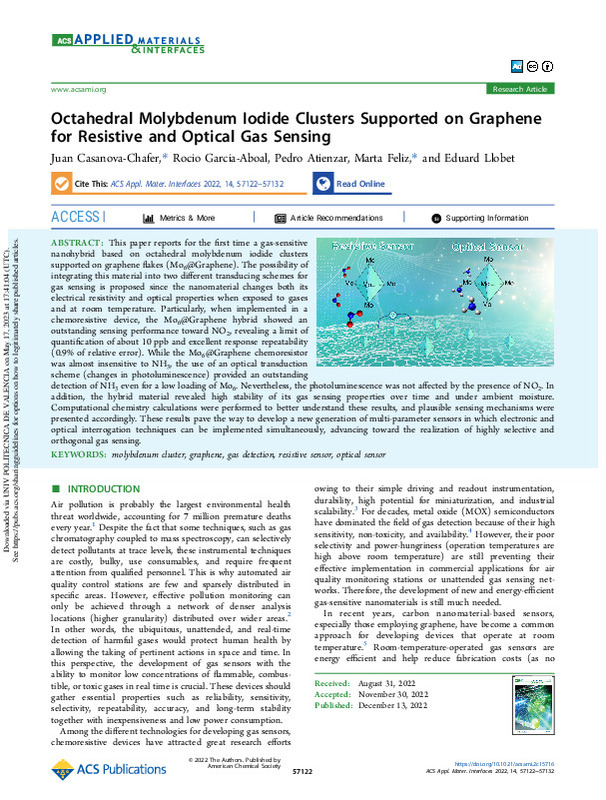JavaScript is disabled for your browser. Some features of this site may not work without it.
Buscar en RiuNet
Listar
Mi cuenta
Estadísticas
Ayuda RiuNet
Admin. UPV
Octahedral Molybdenum Iodide Clusters Supported on Graphene for Resistive and Optical Gas Sensing
Mostrar el registro sencillo del ítem
Ficheros en el ítem
| dc.contributor.author | Casanova-Chafer, Juan
|
es_ES |
| dc.contributor.author | García-Aboal, Rocío
|
es_ES |
| dc.contributor.author | Atienzar Corvillo, Pedro Enrique
|
es_ES |
| dc.contributor.author | Feliz Rodriguez, Marta
|
es_ES |
| dc.contributor.author | Llobet, Eduard
|
es_ES |
| dc.date.accessioned | 2023-11-13T19:03:38Z | |
| dc.date.available | 2023-11-13T19:03:38Z | |
| dc.date.issued | 2022-12-28 | es_ES |
| dc.identifier.issn | 1944-8244 | es_ES |
| dc.identifier.uri | http://hdl.handle.net/10251/199581 | |
| dc.description.abstract | [EN] This paper reports for the first time a gas-sensitive nanohybrid based on octahedral molybdenum iodide clusters supported on graphene flakes (Mo-6@Graphene). The possibility of integrating this material into two different transducing schemes for gas sensing is proposed since the nanomaterial changes both its electrical resistivity and optical properties when exposed to gases and at room temperature. Particularly, when implemented in a chemoresistive device, the Mo-6@Graphene hybrid showed an outstanding sensing performance toward NO2, revealing a limit of quantification of about 10 ppb and excellent response repeatability (0.9% of relative error). While the Mo-6@Graphene chemoresistor was almost insensitive to NH3, the use of an optical transduction scheme (changes in photoluminescence) provided an outstanding detection of NH3 even for a low loading of Mo-6. Nevertheless, the photoluminescence was not affected by the presence of NO2. In addition, the hybrid material revealed high stability of its gas sensing properties over time and under ambient moisture. Computational chemistry calculations were performed to better understand these results, and plausible sensing mechanisms were presented accordingly. These results pave the way to develop a new generation of multi-parameter sensors in which electronic and optical interrogation techniques can be implemented simultaneously, advancing toward the realization of highly selective and orthogonal gas sensing. | es_ES |
| dc.description.sponsorship | J.C.-C. gratefully thanks ICREA Academia (project: 2018 ICREA Academia-01-AJUT). This research was funded from project PID2021-123163OB-I00 funded by MCIN/AEI/10.13039/501100011033/and FEDER A way of making Europe, and Generalitat Valenciana (grant number AICO/2020/149) . This work was partially funded by MICINN and FEDER via grant no. RTI2018-101580-B-I00. E. L. was supported by the Catalan Institution for Research and Advanced Studies via the 2018 Edition of the ICREA Academia Award. | es_ES |
| dc.language | Inglés | es_ES |
| dc.publisher | American Chemical Society | es_ES |
| dc.relation.ispartof | ACS Applied Materials & Interfaces | es_ES |
| dc.rights | Reconocimiento (by) | es_ES |
| dc.subject | Molybdenum cluster | es_ES |
| dc.subject | Graphene | es_ES |
| dc.subject | Gas detection | es_ES |
| dc.subject | Resistive sensor | es_ES |
| dc.subject | Optical sensor | es_ES |
| dc.title | Octahedral Molybdenum Iodide Clusters Supported on Graphene for Resistive and Optical Gas Sensing | es_ES |
| dc.type | Artículo | es_ES |
| dc.identifier.doi | 10.1021/acsami.2c15716 | es_ES |
| dc.relation.projectID | info:eu-repo/grantAgreement/AEI/Plan Estatal de Investigación Científica y Técnica y de Innovación 2017-2020/RTI2018-101580-B-I00/ES/SENSADO DE GASES DISTRIBUIDO Y AUTONOMO EMPLEANDO NANOMATERIALES DE BAJA DIMENSION/ | es_ES |
| dc.relation.projectID | info:eu-repo/grantAgreement/GVA//AICO%2F2020%2F149/ | es_ES |
| dc.relation.projectID | info:eu-repo/grantAgreement/MICINN//PID2021-123163OB-I00//Proyectos de generación de conocimiento, Convocatoria 2021/ | es_ES |
| dc.rights.accessRights | Abierto | es_ES |
| dc.contributor.affiliation | Universitat Politècnica de València. Instituto Universitario Mixto de Tecnología Química - Institut Universitari Mixt de Tecnologia Química | es_ES |
| dc.description.bibliographicCitation | Casanova-Chafer, J.; García-Aboal, R.; Atienzar Corvillo, PE.; Feliz Rodriguez, M.; Llobet, E. (2022). Octahedral Molybdenum Iodide Clusters Supported on Graphene for Resistive and Optical Gas Sensing. ACS Applied Materials & Interfaces. 14(51):57122-57132. https://doi.org/10.1021/acsami.2c15716 | es_ES |
| dc.description.accrualMethod | S | es_ES |
| dc.relation.publisherversion | https://doi.org/10.1021/acsami.2c15716 | es_ES |
| dc.description.upvformatpinicio | 57122 | es_ES |
| dc.description.upvformatpfin | 57132 | es_ES |
| dc.type.version | info:eu-repo/semantics/publishedVersion | es_ES |
| dc.description.volume | 14 | es_ES |
| dc.description.issue | 51 | es_ES |
| dc.identifier.pmid | 36511821 | es_ES |
| dc.identifier.pmcid | PMC9801382 | es_ES |
| dc.relation.pasarela | S\480452 | es_ES |
| dc.contributor.funder | Generalitat Valenciana | es_ES |
| dc.contributor.funder | Agencia Estatal de Investigación | es_ES |
| dc.contributor.funder | European Regional Development Fund | es_ES |
| dc.contributor.funder | Ministerio de Ciencia e Innovación | es_ES |
| dc.contributor.funder | Universitat Politècnica de València | es_ES |
| dc.contributor.funder | Institució Catalana de Recerca i Estudis Avançats | es_ES |








